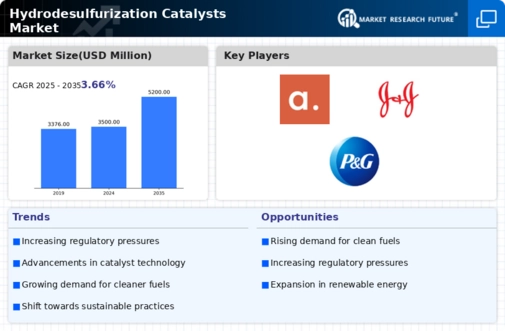Market Share
Hydrodesulfurization Catalysts Market Share Analysis
In the competitive Hydrodesulfurization (HDS) Catalysts Market, companies employ a range of strategies to secure their market share and establish a strong positioning. One key strategy involves product differentiation. HDS catalyst manufacturers focus on offering a diverse range of catalyst formulations with different compositions, active metal content, and pore structures to cater to the specific needs of various refining processes and applications. By providing options such as cobalt-molybdenum, nickel-molybdenum, or nickel-tungsten catalysts with varying specifications, companies can target different market segments and appeal to a broad spectrum of customers with varying requirements for sulfur removal efficiency, activity, and selectivity. This strategy of product differentiation enables companies to stand out in the market by offering tailored solutions that meet specific refining needs and performance standards.
The purpose of removing the sulfur from these fuel oils and natural gas is to reduce the sulfur dioxide emissionsresulting fromseveral combustions. In the catalystic reforming units, the removal of sulfur is important as it can poisons the noble metal catalysts such as rhenium and platinum, evn at low concentrations. These are subsequently used to upgrading the octane rating of the naphtha streams. Damage to these precious metal catalysts can severely impact the process and leading tohigh costs.
Pricing strategy is another critical aspect of market share positioning in the HDS Catalysts Market. Companies often adopt different pricing strategies based on factors such as catalyst performance, metal loading, and target market segments. Some companies may opt for a premium pricing strategy, positioning their HDS catalysts as high-performance materials targeted at customers who prioritize sulfur removal efficiency and are willing to pay a premium price for superior quality and reliability. Conversely, other companies may choose a value-based pricing strategy, offering competitive prices to gain market share rapidly, especially in price-sensitive market segments such as smaller refineries or regions with lower refining margins. Additionally, promotional pricing tactics such as volume discounts or long-term supply contracts are also utilized to attract customers and increase market share.
Distribution channels play a crucial role in market share positioning for HDS catalyst manufacturers. Companies need to ensure their catalysts are readily available to customers through efficient distribution channels. This involves partnering with refining companies, catalyst handling services, and catalyst loading facilities with a wide reach and strong distribution networks. Additionally, companies may also invest in their distribution infrastructure, including regional warehouses and logistics facilities strategically located to ensure timely delivery of catalysts to refineries across different geographic regions and markets. By optimizing their distribution channels, companies can enhance their market presence and gain a competitive edge over rivals.
Branding and marketing strategies are instrumental in establishing a strong market share positioning in the HDS Catalysts Market. Building a reputable brand image helps companies differentiate themselves from competitors and influence customer perceptions positively. HDS catalyst manufacturers invest in branding initiatives that highlight the performance, reliability, and efficiency of their catalysts, as well as their commitment to innovation and technical support. This could include showcasing case studies of successful HDS applications, obtaining certifications related to catalyst performance and environmental standards, and engaging in educational initiatives to raise awareness about the benefits of using high-quality HDS catalysts. Additionally, effective marketing strategies such as targeted advertising, participation in industry conferences, and collaboration with engineering firms and consulting companies help companies increase brand visibility and reach a wider audience, ultimately driving market share growth.
Innovation and product development are also crucial components of market share positioning strategies in the HDS Catalysts Market. Companies strive to differentiate themselves by continuously innovating and introducing new catalyst formulations with enhanced properties and performance characteristics. This could involve developing catalysts with improved activity, selectivity, and stability for processing heavier feedstocks or achieving lower sulfur specifications, or incorporating novel support materials and promoters to enhance catalyst performance and longevity. By staying ahead of the curve in terms of product innovation and technological advancements, companies can capture market share by offering cutting-edge solutions that meet the evolving needs of refineries and comply with increasingly stringent environmental regulations.
Strategic partnerships and collaborations are another avenue for market share positioning in the HDS Catalysts Market. Collaborating with refining companies, engineering firms, and research institutions allows companies to showcase their catalysts in real-world applications and gain credibility. Strategic partnerships with catalyst suppliers, equipment manufacturers, and catalyst testing laboratories can also help companies gain access to new technologies, market insights, and distribution channels. By leveraging the strengths of partners and collaborating on joint marketing efforts, companies can strengthen their market share positioning and achieve sustainable growth in the competitive HDS Catalysts Market.














Leave a Comment